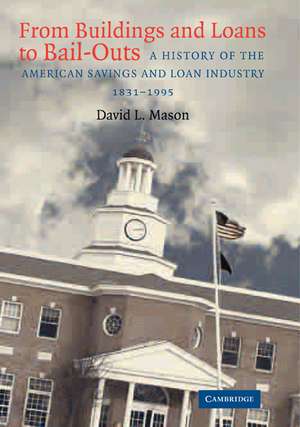From Buildings and Loans to Bail-Outs: A History of the American Savings and Loan Industry, 1831–1995
Autor David L. Masonen Limba Engleză Paperback – 11 feb 2009
| Toate formatele și edițiile | Preț | Express |
|---|---|---|
| Paperback (1) | 273.35 lei 6-8 săpt. | |
| Cambridge University Press – 11 feb 2009 | 273.35 lei 6-8 săpt. | |
| Hardback (1) | 593.12 lei 6-8 săpt. | |
| Cambridge University Press – 4 iul 2004 | 593.12 lei 6-8 săpt. |
Preț: 273.35 lei
Nou
Puncte Express: 410
Preț estimativ în valută:
52.30€ • 54.61$ • 43.29£
52.30€ • 54.61$ • 43.29£
Carte tipărită la comandă
Livrare economică 05-19 aprilie
Preluare comenzi: 021 569.72.76
Specificații
ISBN-13: 9780521101226
ISBN-10: 0521101220
Pagini: 364
Ilustrații: 17 tables
Dimensiuni: 152 x 229 x 21 mm
Greutate: 0.53 kg
Editura: Cambridge University Press
Colecția Cambridge University Press
Locul publicării:New York, United States
ISBN-10: 0521101220
Pagini: 364
Ilustrații: 17 tables
Dimensiuni: 152 x 229 x 21 mm
Greutate: 0.53 kg
Editura: Cambridge University Press
Colecția Cambridge University Press
Locul publicării:New York, United States
Cuprins
Introduction; 1. A movement takes shape, 1831–99; 2. The rise of the league, 1900–29; 3. From State to Federal oversight; 4. The movement becomes an industry, 1930–45; 5. The glory years, 1946–55; 6. External challenges and internal divisions, 1956–66; 7. Lost opportunities, 1967–79; 8. Deregulation and disaster 1979–88; 9. Resolving the crisis, restoring the confidence, 1989–95; 10. The American savings and loan industry in perspective; Appendices; Bibliography; Index.
Recenzii
"Mason has produced a readable introduction to the S&L industry. Recommended." R. Grossman, Wesleyan University, CHOICE
"[T]he first complete history of the savings and loan industry." Towns Country Herald
"Mason shows that thrifts, though European in origin, thrived in the US because they became the quintessential American institutions, ones based on voluntary association, dedicated to self-help and, ultimately, egalitarian in spirit and operation. Thrifts were run by and for the Irish, for Catholics, for Slovaks, for Poles, for railroad workers and for shopkeepers. There were even thrifts run by and for women and blacks long before other institutions welcomed or served them. Mason repeatedly reminds us that the thrift industry was envisioned as a leveling mechanism, one that promoted home ownership and renewed their participants' faith in the American dream." Howard Bodenhorn, Associate Professor of Economics, Lafayette College
"Here is a compact, authoritative, well-written history of the savings and loan industry from its modest start in 1831 to its partial recovery at the end of the twentieth century. Dr. David Mason has used his training as a business historian, as well as almost a decade of banking experience, to good advantage. Political as well as economic forces are thoughtfully presented. From Building and Loans to Bail-Outs reflects painstaking research." Benjamin J. Klebaner, Professor of Economics, The City College of the City University of New York
"...excellent, well-researched and well-written.." EH.net
"In this readable and well-paced treatment Mason places the S&L crisis into the broad historical sweep of the American thrift industry. Mason traces the development of the symbiotic, complex and sometimes dysfunctional relationship between the thrift industry's trade group and federal government regulation with meticulous scholarship and a keen eye for the broader social and economic context. The notes and references by themselves offer a valuable resource for any scholar interested in the field." Kenneth Snowden, Bryan School of Business and Economics, University of North Carolina, Greensboro
"Anyone studying the savings and loan industry in the United States will have to consult this book. Its lengthy footnotes, as well as its text, serve as a valuable guide for researchers." - American Historical Review, Marc Egnal, York University
"[T]he first complete history of the savings and loan industry." Towns Country Herald
"Mason shows that thrifts, though European in origin, thrived in the US because they became the quintessential American institutions, ones based on voluntary association, dedicated to self-help and, ultimately, egalitarian in spirit and operation. Thrifts were run by and for the Irish, for Catholics, for Slovaks, for Poles, for railroad workers and for shopkeepers. There were even thrifts run by and for women and blacks long before other institutions welcomed or served them. Mason repeatedly reminds us that the thrift industry was envisioned as a leveling mechanism, one that promoted home ownership and renewed their participants' faith in the American dream." Howard Bodenhorn, Associate Professor of Economics, Lafayette College
"Here is a compact, authoritative, well-written history of the savings and loan industry from its modest start in 1831 to its partial recovery at the end of the twentieth century. Dr. David Mason has used his training as a business historian, as well as almost a decade of banking experience, to good advantage. Political as well as economic forces are thoughtfully presented. From Building and Loans to Bail-Outs reflects painstaking research." Benjamin J. Klebaner, Professor of Economics, The City College of the City University of New York
"...excellent, well-researched and well-written.." EH.net
"In this readable and well-paced treatment Mason places the S&L crisis into the broad historical sweep of the American thrift industry. Mason traces the development of the symbiotic, complex and sometimes dysfunctional relationship between the thrift industry's trade group and federal government regulation with meticulous scholarship and a keen eye for the broader social and economic context. The notes and references by themselves offer a valuable resource for any scholar interested in the field." Kenneth Snowden, Bryan School of Business and Economics, University of North Carolina, Greensboro
"Anyone studying the savings and loan industry in the United States will have to consult this book. Its lengthy footnotes, as well as its text, serve as a valuable guide for researchers." - American Historical Review, Marc Egnal, York University
Notă biografică
Descriere
The overall historical perspective sheds new light on the events of the 1980s and analyses the efforts to rehabilitate the industry in the 1990s.











